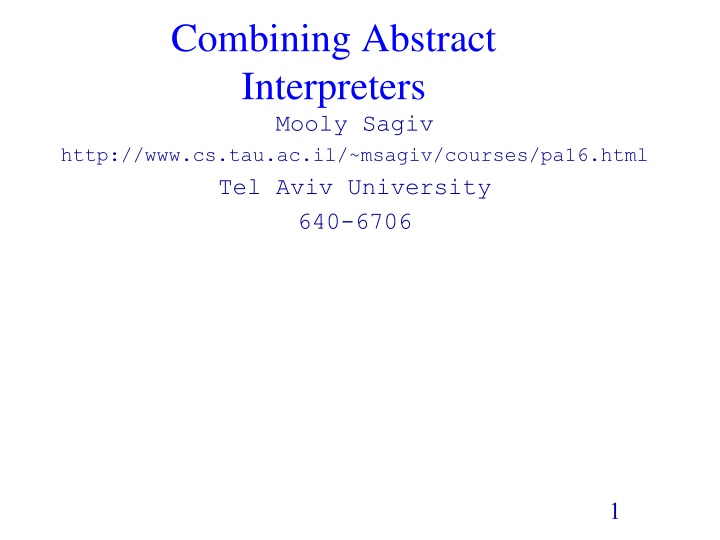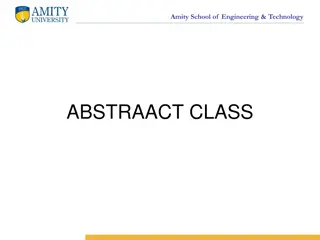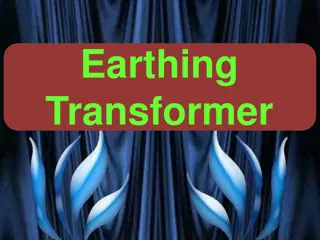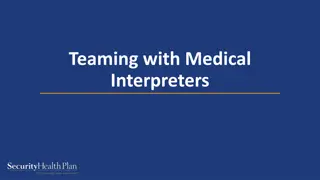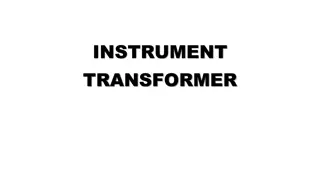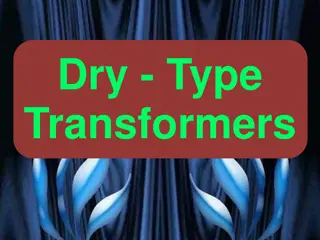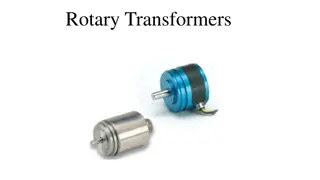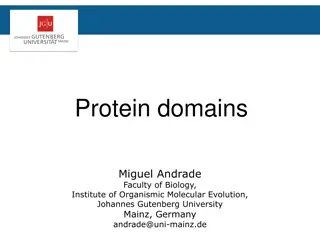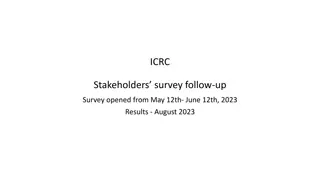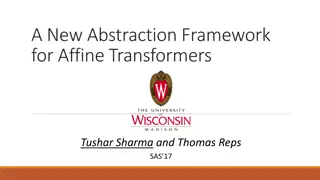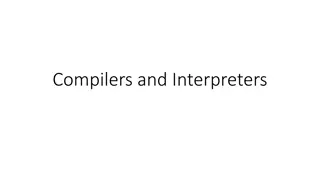Combining Abstract Interpreters: Developing New Transformers and Domains with Pointer Semantics
Uncover the art of developing advanced abstract interpreters by leveraging old methodologies to pave the way for new transformers and abstract domains. Delve into pointer semantics, control flow graphs, disjunctive completion, and galois connections for enhanced precision. Explore examples and solutions to maximize the efficacy of abstract composition.
Download Presentation

Please find below an Image/Link to download the presentation.
The content on the website is provided AS IS for your information and personal use only. It may not be sold, licensed, or shared on other websites without obtaining consent from the author.If you encounter any issues during the download, it is possible that the publisher has removed the file from their server.
You are allowed to download the files provided on this website for personal or commercial use, subject to the condition that they are used lawfully. All files are the property of their respective owners.
The content on the website is provided AS IS for your information and personal use only. It may not be sold, licensed, or shared on other websites without obtaining consent from the author.
E N D
Presentation Transcript
Combining Abstract Interpreters Mooly Sagiv http://www.cs.tau.ac.il/~msagiv/courses/pa16.html Tel Aviv University 640-6706 1
Motivation Develop new abstract interpreters from old If I know how to handle programs over data type A and programs over data type B How can I handle programs with variables of type A or type B Develop new abstract domains from old Develop new transformers from old
Simple Pointer Commands X, Y Var <com> ::= X := Y | X := &Y | *X := Y | assume X = Y | assume *X = Y | assert X = Y | assert *X = Y Control Flow Graph G(N, E, s) where E N N is annotated with commands s N is the start node
Example Program 1 A1 := &B1 2 A2 := &B2 3 X := &A1 X := &A2 4 5 6 *X := B1 7
Disjunctive Completion Given an abstract domain D Construct an abstract domain D such that join does not lose information How can this be formulated? Examples: Signs = { , {+}, {-}. {0}, {0, +}, {0, -}, Z} Points-to Size of the new domin Height of the new abstract domain Finite lattices Infinite lattice Constructing transformers
Example Program 1 A1 := &B1 2 A2 := &B2 3 X := &A1 X := &A2 4 5 6 *X := B1 7
Cartesian Product Given domains D1=<D1, D2=<D2, Construct a domain D =<D1 D2, , , , , ) Galois connection Is it a Galois insertion Widening Transformers for (i=0; i < arr.length ; i++) 1, 1, 1, 1, 1) and 2, 2, 2, 2, 2) arr[i] = 0
Reduced Product Cartesian product does not utilize the interaction between the domains How can each analysis in the abstract composition benefits from the information brought by the other analyses Two solutions Employ a theorem prover Employ semantic reduction
Semantic Reduction Improve the precision of the analysis by recovering properties of the program semantics A Galois connection (L1, , , L2) An operation op:L2 L2is a semantic reduction l L2 op(l) l (op(l)) = (l) The most precise semantic reduction can be defined but not-necessarily computed Can be applied before and after basic operations L1 L2 l op
Example D1= Intervals D2 = Parity Example Reduction: Update lower/upper bound
Granger Product A general heuristics for approximating semantic reduction D1=<D1, D2=<D2, D =< D1 D2, , , , , ) Define operations: 1: D1 D2 D1 and 2: D1 D2 D2 such that 1 (d1, d2) 1 d1 and ( 1 (d1, d2), d2) = (d1, d2) 2 (d1, d2) 2 d2and (d1, 2 (d1, d2) ) = (d1, d2) Compute the semantic reduction iteratively <a0, b0> = <a, b> <an+1, bn+1> = < 1 (an, bn), 2(an, bn) > 1, 1, 1, 1, 1) 2, 2, 2, 2, 2)
A Simple Example [Intervals+Inqualities] if (I <= 0) arr = new Int[1] else arr = new Int[I] for (i=0; i < I ; i++) arr[i] = 0;
A Complex Example [Intervals+Inqualities] if (I <= 2) arr = new Int[1] else arr = new Int[I] for (i=3; i < I ; i++) arr[i] = 0;
Reduced Cardinal Power Combine the two domains in a way which keeps correlations between the individual elements The element a b means that if the state obeys a it also obeys b
Reduced Cardinal Power Given domains D1=<D1, D2=<D2, Construct a domain D =<D1 D2, , , , , ) Galois connection Transformers 1, 1, 1, 1, 1) and 2, 2, 2, 2, 2)
A Complex Example [Intervals+Inqualities] if (I <= 2) arr = new Int[1] else arr = new Int[I] for (i=3; i < I ; i++) arr[i] = 0;
A Complex Example [Booleans+Signs] x := 100; b := true; while b do { x := x 1; b := (x > 0); }
Practical Applications of Reduced Cardinal Power Astree Branch Correlations Interprodecural analysis [Next lesson] Shape Analysis [Later]
Other Combinations Open Product Logical Product
Bibliography Cousot & Cousot POPL 1979 Bruno Blachet, Introduction to Abstract Interpretation A. Cortesi, G. Contanini, P. Ferrrara: A survey o Product Operator in Abstract Interpretations Roberto Giacobazzi, Francesco Ranzato: Optimal Domains for Disjunctive Abstract Intepretation. Sci. Comput. Program. 32(1-3): 177-210 Sumit Gulewani, Ashish Tiwari: Combining abstract interpreters PLDI 06
Summary Many ways to combine abstractions Simplifies the design and implementation of static analyzers Improve our understanding of abstractions
